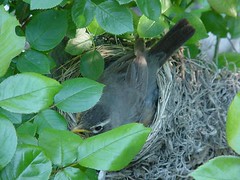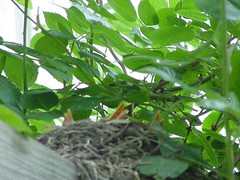The robin's nest under my window - Part 2
Fun stuff for pet lovers
We have great fun selling our high quality pet supplies at discounted prices, but we also have fun with our pets!
Our fun stuff pages of Internet Pet Supplies website are devoted to the humor and enjoyment that is daily found in living with our animal companions.
Take a break from shopping for pet supplies and spend a few minutes enjoying some fun pet stuff ...
The Robin's Nest Under My Window
May 14, 2005 through June 10, 2005
This is PART TWO of the story. Part one is HERE
May 26, 2005
May 26, 2005. Day fourteen since I discovered the robin's nest under my bedroom window. The oldest egg is 13 days old today.
The mama robin used to fly away when she heard me at the window. Now, either she's getting used to me, or she wants to really stay close to her eggs, but she's hanging around until picture taking is over with.
Here's how she looked today, waiting patiently for me to get done with my egg exam.
And here's what the eggs look like today:
May 27, 2005
May 27, 2005. Day fifteen since I discovered the robin's nest under my bedroom window.
It's been fourteen days since the first egg was laid.
Today, the mama bird refuses to leave the nest for our photo session. I don't know if any eggs have hatched or not & don't want to startle her for fear that she will just abandon the nest.
Some facts about robins:
Common
Name: American robin
French: Merle d'Amérique
Spanish: Mirlo primavera
Scientific
Name: Turdus migratorius
Order PASSERIFORMES - Family TURDIDAE
Society:
In summer, females sleep on the nests and males congregate in
roosts. As young robins become independent, they join the males
in the roost. Female adults go to the roosts only after they have
finished nesting.
Nesting:
An American Robin can produce three successful broods in
one year. On average, though, only 40 percent of nests successfully
produce young.
Life-time: About half of the robins alive in any year will make it to the next. Despite the fact that a lucky robin can live to be 14 years old, the entire population turns over on average every six years.
May 28, 2005
I checked the nest at 7 a.m. Again, today, the mama bird wouldn't move out of the nest. One egg or egg shell was visible under her feathers.
I checked again at 9:00 a.m. Hey! Hey! We have three gorgeous little baby robins! Click for larger photo.
Now, I watch from the ground outside - there's a lot of activity, both the male and female come and go, but one is usually in the nest, protecting the babies.
When neither adult is around, I run inside to try to grab a photo. What we noticed right away is that there are no left over egg shells either in the nest or on the ground under the nest. Amazing that the birds would clean this up.
May 29, 2005
Baby robins, day 2
It's difficult to get pictures of the babies, the male and female take turns covering them for warmth. While one is in the nest, the other is out gathering food. They will leave the nest if I open the window and lean out with the camera, but I don't want to scare them and have them abandon the babies.
Some facts about robins:
Song: The robin is one of the first birds to sing in the morning and is one of the last to be heard at night. The male is most vocal, usually singing from high points in the morning and during courtship. The robin is one of the few birds to sing throughout the winter.
Diet:
Though we think of robins as eating mainly earthworms,
in fact earthworms and other invertebrates make up about 40 percent
of its diet. Most of their food is fruit. They find earthworms
by sight rather than by sound. They eat invertebrates mainly in
the spring, summer and early morning, but rely on fruit later
in the day, in the fall and winter. Their preferred fruits are
grapes, cherries, tomatoes, pokeberries, mistletoe berries, rowan
berries and in southern states, the fruits of the Sabal Palm.
Robins also eat beetles, grasshoppers and other insects. Occasionally,
robins eat small snakes and shrews, and they sometimes go on the
seashore at low tide for molluscs or in water to pick up fish
fry.
Chicks: The chicks are fed by both parents. They eat about 35 to 40 meals a day. The parents keep the nests clean by carrying away or eating the chicks' fecal sacs.
May 30, 2005
Baby robins, day three
May 30 - The chicks are little less pink and less sore looking than they were yesterday.
The male and female robin got into a confrontation with another bird this afternoon. A starling was hanging around and maybe acted a little too interested in the robins' nest. Mama robin dove to the ground and stumbled around with her wing extended as if she were injured. While the starling watched the female robin, the male robin attacked the starling. This went on for a few minutes until the starling decided it had had enough & flew away.
May 31, 2005
Baby robins, day four
May 31 - This is about all you see all day long now - chicks with beaks open, waiting for food. I wouldn't want to be the one keeping those hungry little bellies filled. Click for larger photo
Both adults are very attentive to the chicks and the surrounding area. For as dirty as birds usually are, the nest is spotless. There are no feathers or debris on the ground under the nest.
It seems that the male and female take equal turns covering the chicks to warm them and also to hunt for food and to feed the chicks.
June 1, 2005
Baby robins, day five
June 1 - What a noticeable change since yesterday. The largest
chick now has what are the obvious beginnings of pin feathers.
Like most babies, they spend most of the day sleeping. When awake, they're shrieking for food.
Some facts about robins:
Chicks:
The father becomes more involved in feeding and nest maintenance
as the chicks get older because the mother might have left to
build a new nest for the next brood. When they are about 13 days
old, the chicks leave the nest. They stay in their parents' territory
for a few weeks but leave after about a month.
Wintering: Robins roost, or collect in flocks. Males do this year round, but the females and young join them during the winter. Roosts can get as big as 250,000 birds, but normally they are 20 to 200 birds.
Even though the robin is a symbol of spring, it actually spends its winter in much of its breeding range. In winter they spend less time in yards and more time in large flocks, so they are seen less often.
June 2, 2005
Mama robin usually flies away when I crank the window open, or she turns her back and ignores me. Today she was just standing on the edge of the nest, admiring her offspring, and instead of flying away, she turned and looked right at me.
Then, she gave a horrendous loud shriek and flew off!
Scared me so bad, I almost fell out of the window.
Here's what the 5-day old chicks look like:
June 3, 2005
Baby Robins - Day 7
I heard the chicks cheeping for the first time today. Even with
their beaks open, they've been quiet so far, but today, even with
the window closed, I could tell that it was dinner time. Click for larger photo
The chick at the bottom left has his eye open! How amazing that
must be - 15 days in a small, cramped eggshell, 6 days in a mysterious
dark world, and suddenly, light!
June 4, 2005
Baby Robins - Day 8
All lined up, beaks ready, waiting for mom or dad to bring the food.
June 5, 2005
Baby robins - day 9
The downy, underfeathers are filling in. The chicks have less pink, bald spots now.
They spend most of the day sleeping but in an unusual position - they rest their heads, beak up, on the edge of the nest. Even while asleep, a beak opens every now and then.
Dreams of food?
June 6, 2005
Baby robins - day 10
Day 10 since the eggs have hatched.
They're almost starting to look like birds, aren't they?
The little beaks look less awkward, the eyes aren't so bulbous. Their feathers are filling in.
I haven't seen any of the chicks stand up yet. I've seen them reach their necks out to almost impossible lengths and open their beaks to an enormous gape. From the ground, under the nest, you can see a little beak hanging over the edge of the nest every now and then.
June 7, 2005
Baby robins - day 11
June 7. Here's what you see from the ground - three little pointy, hungry beaks.
More feathers have grown since yesterday.
The chicks have arranged themselves for easier feeding, all lined up and waiting.
Mom & dad robin spend pretty much the entire day flying back and forth, making food deposits.
June 8, 2005
Baby robins - day 12 since hatching
June 8
The chicks are maturing.
The middle chick is growing orangey-red feathers under his throat.
I guess they are officially robins now!
June 9, 2005
Baby robins - day 13 since hatching
June 9
The chicks are looking pretty grown up.
I wonder how much longer they'll stay in the nest. Click for larger photo
June 10, 2005
Robin's nest - day 14 since eggs hatched
June 10
Into the great wide open,
Under them skies of blue
Good bye little sweeties,
Catch lots of worms
Eat bunches of ripe berries
Come back and sing for me once in a while.
Photos and text by Julie Corsi
Original photos are at Flickr
(http://www.flickr.com/photos/corsinet/sets/336251/with/18595625/)
I will miss doing this each day.
It's been fun.























